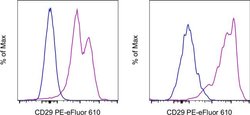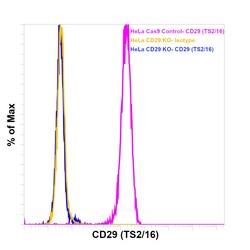Learn More
CD29 (Integrin beta 1) Monoclonal Antibody (TS2/16), PE-eFluor™ 610, eBioscience™, Invitrogen™


Mouse Monoclonal Antibody
$477.00
Specifications
| Antigen | CD29 (Integrin beta 1) |
|---|---|
| Clone | TS2/16 |
| Applications | Flow Cytometry |
| Classification | Monoclonal |
| Conjugate | PE-eFluor 610 |
| Catalog Number | Mfr. No. | Quantity | Price | Quantity & Availability | |||||
|---|---|---|---|---|---|---|---|---|---|
| Catalog Number | Mfr. No. | Quantity | Price | Quantity & Availability | |||||
61-029-942
 
|
Invitrogen™
61029942 |
100 Tests |
Each of 1 for $477.00
|
|
|||||
Description
Description: The TS2/16 monoclonal antibody reacts with human CD29, also known as integrin beta 1, an approximately 130 kDa single-pass transmembrane glycoprotein. CD29 complexes with one of nine integrin alpha subunits to form the very late antigen (VLA) subfamily of adhesion molecules. Integrin heterodimers containing CD29 are involved in cell-cell and cell-matrix adhesion. CD29 is expressed broadly on lymphocytes and monocytes, with lower levels of expression on granulocytes. The TS2/16 antibody has been found to possess activating activity for beta 1 integrins. Applications Reported: This TS2/16 antibody has been reported for use in flow cytometric analysis. Applications Tested: This TS2/16 antibody has been pre-diluted and tested by flow cytometric analysis of normal human peripheral blood cells. This may be used at 5 μL (0.25 μg) per test. A test is defined as the amount (μg) of antibody that will stain a cell sample in a final volume of 100 μL. Cell number should be determined empirically but can range from 10^5 to 10^8 cells/test. PE-eFluor 610 can be excited with laser lines from 488-561 nm and emits at 607 nm. We recommend using a 610/20 band pass filter (equivalent to PE-Texas Red). Please make sure that your instrument is capable of detecting this fluorochrome. Light sensitivity: This tandem dye is sensitive to photo-induced oxidation. Please protect this vial and stained samples from light.
ITGB1 (Integrin Subunit Beta 1, beta1 integrin subunit, GPIIa, CD29) is a 110 kDa cell surface glycoprotein that is widely expressed by a variety of cells including all leucocytes. ITGB1 forms non-covalently linked heterodimers with at least 6 different alpha chains (alpha1-alpha6, CDa-f) determining the binding properties of beta1 (VLA) integrins. ITGB1 is a cell adhesion molecule appearing on platelets, as the common Beta subunit of the very late activation antigen (VLA), and as a component of various protein complexes binding to extracellular matrix proteins. Decreased expression of ITGB1 correlates with acquiring multidrug resistance of tumor cells in the presence of anti-tumor drug. ITGB1 is up-regulated in leukocytes during emigration and extravascular migration and appear to be critically involved in regulating the immune cell trafficking from blood to tissue. Further, ITGB1 also regulates tissue damage and disease symptoms related to inflammatory bowel disease. Through an ITGB1-dependent mechanism, fibronectin and type I collagen enhance cytokine secretion of human airway smooth muscle in response to IL-1beta. More than 8 beta subunits with numerous splice variant isoforms have been identified in mammals. There are two major forms of integrin beta1: beta1A and beta1D, which differ in 13 amino acids. The distribution pattern in adult tissues for integrin beta types are mutually exclusive. Beta1A is present in all tissues, except cardiac and skeletal muscle which express the beta1D variant.Specifications
| CD29 (Integrin beta 1) | |
| Flow Cytometry | |
| PE-eFluor 610 | |
| Mouse | |
| Human | |
| 3688 | |
| IgG1 κ | |
| 4°C, store in dark, DO NOT FREEZE! | |
| ITGB1 |
| TS2/16 | |
| Monoclonal | |
| Liquid | |
| RUO | |
| P05556 | |
| ITGB1 | |
| Primary | |
| Antibody |
The Fisher Scientific Encompass Program offers items which are not part of our distribution portfolio. These products typically do not have pictures or detailed descriptions. However, we are committed to improving your shopping experience. Please use the form below to provide feedback related to the content on this product.


